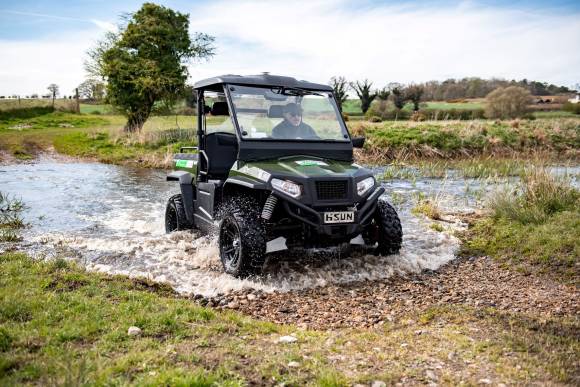Published on 20th September, 2022
British agriculture is facing challenge and opportunity on both the homefront and in global markets, with climate change, volatility and food security driving change across all sectors.
This year’s Dairy Show will bring together knowledge, innovation, and a shared determination to tackle these key challenges, helping milk producers maximise today’s and tomorrow’s opportunities.
So what innovation and discussions can visitors expect to across the 300+ trade stands and in the seminar sessions?
Cow monitoring
Cow health champion and Cream Award winner for innovation, Herdvision will be at the show with its automated body condition and mobility scoring camera technology – a first of its kind on the market.
Using 2D and 3D technology, a small camera records cows when they are in a relaxed state, explains head of sales, Stuart Adams. “Cows naturally perceive people as predators; they try to hide ailments, making it difficult to observe earlier stages of disease and pain.
“Manual observations are subjective,” he adds. “The technology is consistent, objective and repeatable.”
Positioned above a single-track race, the unobtrusive camera records images of each cow as they pass underneath. Cloud-based artificial intelligence (AI), machine learning, and algorithms then process key metrics to determine body condition and mobility scores.
A change in a cow’s condition or mobility will be sent as an alert to the farmer’s PC and/or smartphone. “Farmers can then drill down further into data with their vet, nutritionist, and foot-trimmer to identify trends and implement actions that make improvements to health and welfare.”
Developed in association with Arla, the processor is now accepting the data for mobility scoring compliance. And a Kingshay cost-benefit analysis suggests an annual saving of £22,169 for a typical 200-cow herd (£111/cow) in lameness reduction and associated labour costs alone.
Slurry Inoculant
When it comes to the ‘Dirty Discussions’ seminar sessions, EnviroSystems will be sharing how bacteria and enzymes can help producers capitalise on their slurry’s true value. It will also be giving a progress update on its Defra-sponsored research into slurry emissions.
Organic manures are valuable and can help lessen reliance on bagged fertilisers – but there are challenges, says co-ordinator, Sally Russell. “A lot of nutrients are locked up in the crust and are wasted.”
Slurry treated with SlurryBugs – a blend of beneficial bacteria and enzymes – was found to have a significantly higher nutrient content, worth around 20% more than untreated slurry.
Independently analysed by NRM laboratories, treated slurry had 27% more nitrogen and 45% and 16% more phosphorus and potassium, respectively, when compared to untreated slurry.
“In August, producers needed 1,700 litres of milk to pay for one tonne of nitrogen fertiliser – that’s 800 litres more than between January 2019 and June 2021,” says Ms Russell. The inoculant can therefore make a big financial difference.
“The inoculant also makes slurry more homogenous and easier to spread, giving more uniform nutrient application,” she explains. “And the slurry needs less ongoing agitation – saving time, fuel, and wear and tear on machinery – which of course helps reduce carbon footprint.”
Electric Utility Vehicles
Another environmentally friendly offering is from AC1 Customs, which will be exhibiting two of Electric Wheels’ all-terrain electric utility vehicles (UTVs) that have the capabilities of their fossil-fuelled cousins but without the emissions. “Mules and Gators are on most farms,” says Electric Wheels founder, Chris Hurdle.
“However, we are seeing more farmers showing interest in electric vehicles, as long as they can do the job and provide the same functionality.”
On offer are the Nipper and the Worker, which provide 45-75 miles to the charge – enough for a full working day on 99% of farms.
“It will cost the farmer around £1.50 per working day, which is significantly lower than diesel-powered UTVs; they sit somewhere between £20-£30 per day. Maintenance costs are also much more controlled; annual services average £200 to £300 with cheaper spare parts.”
So how do they shape up in comparison? “On farm, both share the same functionalities of a typical UTV and feature a rear tipper,” says Mr Hurdle. “But being electric they achieve zero emissions, and farmers like the quietness of them around livestock.
“They work in 4×4 and 2×4 drive with some differences between the models. The Nipper is narrower and higher – it’s better suited to farms with narrow access points and tight corners.
“Our most recent step was to offer these models with a lithium battery; a more sustainable battery with greater lifetime capability,” he adds.
Bale Probes
Meanwhile, Cornish Mutual has joined forces with Quanturi to become the first UK supplier of Haytech – a wireless temperature monitoring system for hay and straw bales.
There are over 200 spontaneous combustion incidents every year on farms, which has been steadily increasing due to hot, dry weather, says loss prevention leader, Dominic Jones.
Nadine Pesonen, founder of Quanturi, developed the Haytech probe after a fire devasted her farm business in France, says Mr Jones. “It’s a simple system; the wireless probes are stuck into the hay or straw bale – at least one per 20 bales, making sure probed bales are distributed throughout the stack to monitor high-risk areas.”
Measuring the bale temperature every hour, the probes wirelessly transmit the data to the secure cloud server via a repeater and base station. The farmer will then receive warnings and alerts via text or/and email when alert temperatures are reached.
“Generally these are 58⁰c for a warning alert and 68⁰c for a high-risk alert,” Mr Jones adds. “The Haytech 10 system costs around £1,190 and includes 10 probes, the base station, three years of connectivity and use of the Quanturi insight service – and we offer it to members and non-members alike.
“Someone who’s had a fire will see the value in the system – there are some things you can’t put a price on.”
